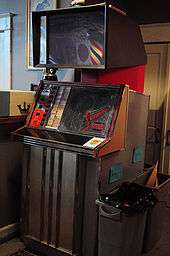Scopitone

Scopitone is a type of jukebox featuring a 16 mm film component. Scopitone films were a forerunner of music videos. The Italian Cinebox/Colorama and Color-Sonics were competing, lesser-known technologies of the time.[1]
Based on Soundies technology developed during World War II,[2] color 16 mm film clips with a magnetic soundtrack were designed to be shown in a specially designed jukebox.
Between 1940 and 1946, three-minute musical films called Soundies (produced in New York City, Chicago and Hollywood) were displayed on a Panoram, the first coin-operated film jukebox or machine music. These were set up in nightclubs, bars, restaurants and amusement centers.
History
The first Scopitones were made in France, by a company called Cameca on Blvd Saint Denis in Courbevoie, among them Serge Gainsbourg's Le poinçonneur des Lilas (filmed in 1958 in the Porte des Lilas Métro station),[3] Johnny Hallyday's "Noir c'est noir" (a cover of Los Bravos' "Black Is Black") and the "Hully Gully" showing a dance around a swimming pool.
Scopitones spread to West Germany, where the Kessler Sisters burst out of twin steamer trunks to sing "Quando Quando" on the dim screen that surmounted the jukebox. Scopitone went on to appear in bars in England, including a coffee bar in Swanage where "Telstar" was a favourite. By 1964, approximately 500 machines were installed in the US.[4] By 1966, reportedly 800 machines were installed in bars and nightclubs in the United States, at a cost of $3500 apiece.[5]
The biggest musical stars of the 1960s were never released on the Scopitone.[6] However, several well-known acts of the 1960s appear in Scopitone films, ranging from the earlier part of the decade The Exciters ("Tell Him") and Neil Sedaka ("Calendar Girl") to Procol Harum ("A Whiter Shade of Pale") later on. In one Scopitone recording, Dionne Warwick lay on a white shag rug with an offstage fan urging her to sing "Walk On By". Another had Nancy Sinatra and a troupe of go-go girls shimmy to "These Boots Are Made for Walkin'". Inspired by burlesque, blonde bombshell Joi Lansing performed "Web of Love" and "The Silencer", and Julie London sang "Daddy" against a backdrop of strippers.[7] The artifice of such scenes led Susan Sontag to identify Scopitone films as "part of the canon of Camp" in her 1964 essay "Notes on 'Camp'."
By the end of the 1960s, the popularity of the Scopitone had faded.[6] The last film for a Scopitone was made at the end of 1978. In 2006, French singer Mareva Galanter released several videos which mimic the Scopitone style. Galenta's album Ukuyéyé features several songs in the French Yé-yé style. She also recently hosted a weekly French television program called "Do you do you Scopitone" on the Paris Première channel.[8]
In 1990, a selection of Scopitones was screened at the Jewel Box theater in Seattle by Dennis Nyback.[9][10]
As of 2012, one of the few Scopitones not in a museum or private collection in the United States is at Third Man Records in Nashville, Tennessee.[11] Many Scopitone films have been released on DVD or made available on the internet.[6]
See also
Footnotes
| Development of the music video | ||||||||||
|---|---|---|---|---|---|---|---|---|---|---|
|
|
||||||||||
- ↑ Cinebox/Colorama Films, ScopitoneArchive.com
- ↑ History of the Scopitone
- ↑ Serge Gainsbourg Article on Forum des Images, February 2003 (in French)
- ↑ David Galassie: Scopitone - The Visual Jukebox. loti.com, accessed 6 September 2008
- ↑ Brack, Ray (July 10, 1965), "Cinema Juke Box: Just a Novelty?", Billboard, retrieved November 7, 2012.
- 1 2 3 Murray, Noel; Phipps, Keith; Tobias, Scott (June 6, 2011), Let's all watch the Scopitone! 15 never-too-popular obsolete entertainment formats, The A.V. Club, retrieved June 6, 2011.
- ↑
- ↑ Paris Première
- ↑ http://moviemorlocks.com/2010/07/01/scopitone-a-go-go/ retrieved March 14, 2015
- ↑ http://scopitones.blogs.com/scopitonescom/2010/12/the-day-i-discovered-scopitones-with-jack-stevenson-dennis-nyback-films.html retrieved March 14, 2015
- ↑ "Third Man Records opens ‘Novelties Lounge’ on Black Friday", The Tennessean, n.d.
References
- Scopitone archive
- NPR: Rise and Fall of the Scopitone Jukebox
- David Galassie: Scopitone: The Visual Jukebox loti.com
External links
| Wikimedia Commons has media related to scopitone. |